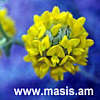 |
||||||||||||||||||||||||||||||||||
|
||||||||||||||||||||||||||||||||||
|
||||||||||||||||||||||||||||||||||
|
|||||||||||||||||||||||
 |
|||||||||||||||||||||||
| - | |||||||||||||||||||||||
|
||||
Status, Endangered Species and Hope (Source for "Pressure" is the 2000 report by the UNEP on Armenia's Biodiversity, and has not been independently confirmed) You will find this familiar to teh risks for birds and fauna. Tat is because they are interdependent, birds especially dependent and supportive of flora, deriving and providing sustenance at the same time. Pressure
Over the last 50 years increased farming has resulted in the loss of natural grasslands and wetlands, while clear cutting forests has resulted in substantial losses in biodiversity. Habitat loss adversely affected resources and nesting for a range of species, with those restricted range species have been particularly affected. Pollution There is a significant increase in pollution in recent years, factories have no real controls over the amount of emissions they can emit. In the name of job security and economic growth, the horrors of over-industrialization before the fall of the Soviet Union may not be so apparent, but they show signs of resuming unfettered pollution. They are still restricted to a few urban areas, but the balance between jobs and the future is a real challenge in Armenia's fragile ecosystem
Climate change An impact of pollution on the natural environment is increasingly being proved to directly affect global warming. Increases of 2-3+ C (4-6+ F) are predicted for Armenia's climate. This equates to a decline in rainfall, resulting in increased risks of desertification. This is likely to severely affect wetland habitats and associated species, while changes in the distribution of habitats may affect the range and viability of a number of species.
Pastures represent around half the agricultural land, and have been severely degraded by overgrazing. Over the last 70 years, there has been increased conversion of semi-desert, steppe and wetland habitats for cultivation, resulting in the loss of some important sites, and increased threats to species. Encroaching pastures and water drainage in the Northern regions are so severe that from dozens of ponds and lakes hat once suported the Armenian water lily throughout the Caucasus there is now only one, and it is further threatened by a nearby aviation enterprise. As serious is the immense loss of water in Lake Sevan and attempts to fix it. Since the 1930s the development of the economy relied on the water resources of the lake. Drainage of its waters supplied irrigation systems for agriculture and hydroelectric power stations downstream. Water from the lake irrigated around 100,000 hectares and generated more than 2.5 million kW of electricity, providing an important contribution to the development of the country. However, such extensive use also resulted in a serious ecological disaster, with significant falls in the level of the lake. Since 1933 the level of the lake fell by 19m, and its overall volume decreased by 42%. As a result the average temperature of the lake increased, oxygenation levels fell, resulting in eutrophication and algal blooms. Once verdent marshland that supported a large variety of wetland flora is now gone. Where once were marhses and bogs, there are now grasslands and semi-desert rocky outcrops. This is reversable, if the water table were allowed to rise again. Perversely, the government continues to bore through the southern montains to channel water form teh Sissian plateau into Lake Sevan, staving off by a few years catastrophic drainage of the lake, but imminent loss of fragile alpine wetlands in Siunik. One wonders where they get these ideas. Governmental Jokes Endangered Species The Good News
And there is time. The departure of up to 1 million people in the last ten years has had the unseen consequence of decreasing pressure on the environment, but as the economy improves, more pressure will come. The typical Armenian inside Armenia actually shows more understanding of the consequences of what they do then those in the Diaspora, which don't even have a record for conservation, let alone understanding. It will be up to local Armenians to repair and conserve, and they may just do it, despite pressure from even their own kind outside to do otherwise.
EcoTourism is the greatest way to educate and give incentives to conserve, and the few Birding Associations involved in Armenia have gone a long way to prove this. Use any EcoTourism group and you will be directly supporting the people who fight for the country.
Climate
Change Info Center-Armenia INDIVIDUAL
REPORTS
|
| |
Search | |
||||||



![[mtn]"](storypage/storyimages/uploaded50kapanmountain1a.jpg)